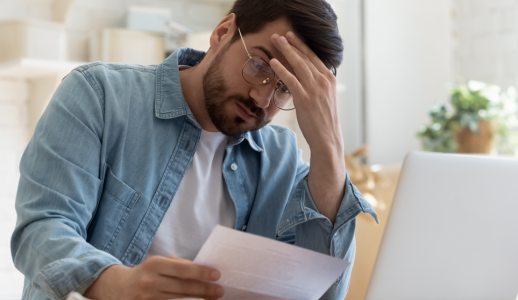Barefoot Investigator warns: $13 food bill turns into $1,300 due to checkout mistake
By
- Replies 27
In today's fast-paced world, convenience often trumps caution, but as one Aussie's costly mistake shows, it might be time to slow down at the checkout.
The Barefoot Investor, Scott Pape, issued an urgent warning about a common shopping habit that could see you out of pocket by hundreds, or even thousands, of dollars.
Imagine this: you pop into your local bakery, order a chicken sandwich, tap your card, and go about your day, only to discover later that you've been charged a whopping $1,300 for what should have been a $13 purchase.
Following his usual routine, the man didn't check the amount he was being charged, entered his PIN, and left without a second thought.
Only days later, upon reviewing his bank statement, he noticed the eye-watering error.
When he approached the bakery for a refund, the owner dismissed him as a scammer and refused to return the money.
To add insult to injury, his bank stated that entering his PIN had legitimised the transaction, leaving him in a financial pickle.
Scott Pape, 46, was taken aback by the letter detailing this incident and used it to remind us of the importance of vigilance.
In his column for the Herald Sun, Pape stressed the value of setting up instant transaction notifications on your phone or smartwatch.
‘Thankfully, my bank flashes up the transaction on my Apple watch and phone after I leave the store,’ he said.
‘Your husband should definitely get that feature.' ‘
This simple step can immediately alert you to any discrepancies in the amount charged, allowing you to address the issue on the spot.
Pape admits to often declining a receipt, considering it a waste of paper and ink, and acknowledged the temptation to tap and go without a second glance.
For those in a similar situation, Pape advised gathering evidence and politely requesting the bank verify the merchant and reverse the transaction.
‘And if they refuse, I’d tell them that your next stop is to the police station where you’re intending to press charges for theft,’ he added.
If the bank or the business refuses to cooperate, he suggested that the next action could be to report the incident to the police as theft.
‘After all, most receipts are a waste of paper and ink,’ he continued.
‘And I know that if I do take one, just to be nice, I’ll shove it in my pocket, and it’ll invariably end up going through the wash, and Liz will yell at me.’
'In fact, if I’m buying something cheap these days, I don’t even hang around to get asked the question. I’m tapping, and I’m going!'
The Australian Competition and Consumer Commission (ACCC) also offered guidance for consumers who encounter purchase issues.
They recommend contacting the business as soon as possible to explain the problem and desired outcome.
Their website states, ‘Phone or visit the business and explain the problem and outcome you want. Do this as soon as possible.'
‘It can also be useful to set out your complaint to the business in writing, by an email or letter. ‘
‘That way they’re clearly aware of the problem, what you want, and you have a record of your contact.’
Should direct contact with the business fail to rectify the situation, the ACCC suggests that legal action may be necessary.
They encourage seeking legal advice and considering small claims courts or tribunals as potential avenues for dispute resolution.
In related news, a Perth café customer vented online after being charged an extra 90 cents to toast his sandwich.
The post about the toasting fee ignited a heated debate, with many users voicing their frustration. Read more about it here.
 Have you ever experienced a similar situation? How do you ensure you're charged the correct amount for your purchases? Share your stories and tips in the comments below.
Have you ever experienced a similar situation? How do you ensure you're charged the correct amount for your purchases? Share your stories and tips in the comments below.
The Barefoot Investor, Scott Pape, issued an urgent warning about a common shopping habit that could see you out of pocket by hundreds, or even thousands, of dollars.
Imagine this: you pop into your local bakery, order a chicken sandwich, tap your card, and go about your day, only to discover later that you've been charged a whopping $1,300 for what should have been a $13 purchase.
Following his usual routine, the man didn't check the amount he was being charged, entered his PIN, and left without a second thought.
Only days later, upon reviewing his bank statement, he noticed the eye-watering error.
When he approached the bakery for a refund, the owner dismissed him as a scammer and refused to return the money.
To add insult to injury, his bank stated that entering his PIN had legitimised the transaction, leaving him in a financial pickle.
Scott Pape, 46, was taken aback by the letter detailing this incident and used it to remind us of the importance of vigilance.
In his column for the Herald Sun, Pape stressed the value of setting up instant transaction notifications on your phone or smartwatch.
‘Thankfully, my bank flashes up the transaction on my Apple watch and phone after I leave the store,’ he said.
‘Your husband should definitely get that feature.' ‘
This simple step can immediately alert you to any discrepancies in the amount charged, allowing you to address the issue on the spot.
Pape admits to often declining a receipt, considering it a waste of paper and ink, and acknowledged the temptation to tap and go without a second glance.
For those in a similar situation, Pape advised gathering evidence and politely requesting the bank verify the merchant and reverse the transaction.
‘And if they refuse, I’d tell them that your next stop is to the police station where you’re intending to press charges for theft,’ he added.
If the bank or the business refuses to cooperate, he suggested that the next action could be to report the incident to the police as theft.
‘After all, most receipts are a waste of paper and ink,’ he continued.
‘And I know that if I do take one, just to be nice, I’ll shove it in my pocket, and it’ll invariably end up going through the wash, and Liz will yell at me.’
'In fact, if I’m buying something cheap these days, I don’t even hang around to get asked the question. I’m tapping, and I’m going!'
The Australian Competition and Consumer Commission (ACCC) also offered guidance for consumers who encounter purchase issues.
They recommend contacting the business as soon as possible to explain the problem and desired outcome.
Their website states, ‘Phone or visit the business and explain the problem and outcome you want. Do this as soon as possible.'
‘It can also be useful to set out your complaint to the business in writing, by an email or letter. ‘
‘That way they’re clearly aware of the problem, what you want, and you have a record of your contact.’
Should direct contact with the business fail to rectify the situation, the ACCC suggests that legal action may be necessary.
They encourage seeking legal advice and considering small claims courts or tribunals as potential avenues for dispute resolution.
In related news, a Perth café customer vented online after being charged an extra 90 cents to toast his sandwich.
The post about the toasting fee ignited a heated debate, with many users voicing their frustration. Read more about it here.
Key Takeaways
- Scott Pape, the Barefoot Investor, has warned Australians to always double-check their charges after an accidental overcharge caused a man to spend $1,300 on a $13 sandwich.
- The man did not realise the error until days later, and when he approached the bakery for a refund, the owner accused him of scamming and denied the refund.
- Scott Pape advises setting up bank notifications on a phone or smartwatch to immediately alert consumers of transaction amounts.
- The Australian Competition and Consumer Commission (ACCC) recommends contacting the business first in case of issues and, if unresolved, considering legal consultation or taking claims to small claims courts or tribunals.








